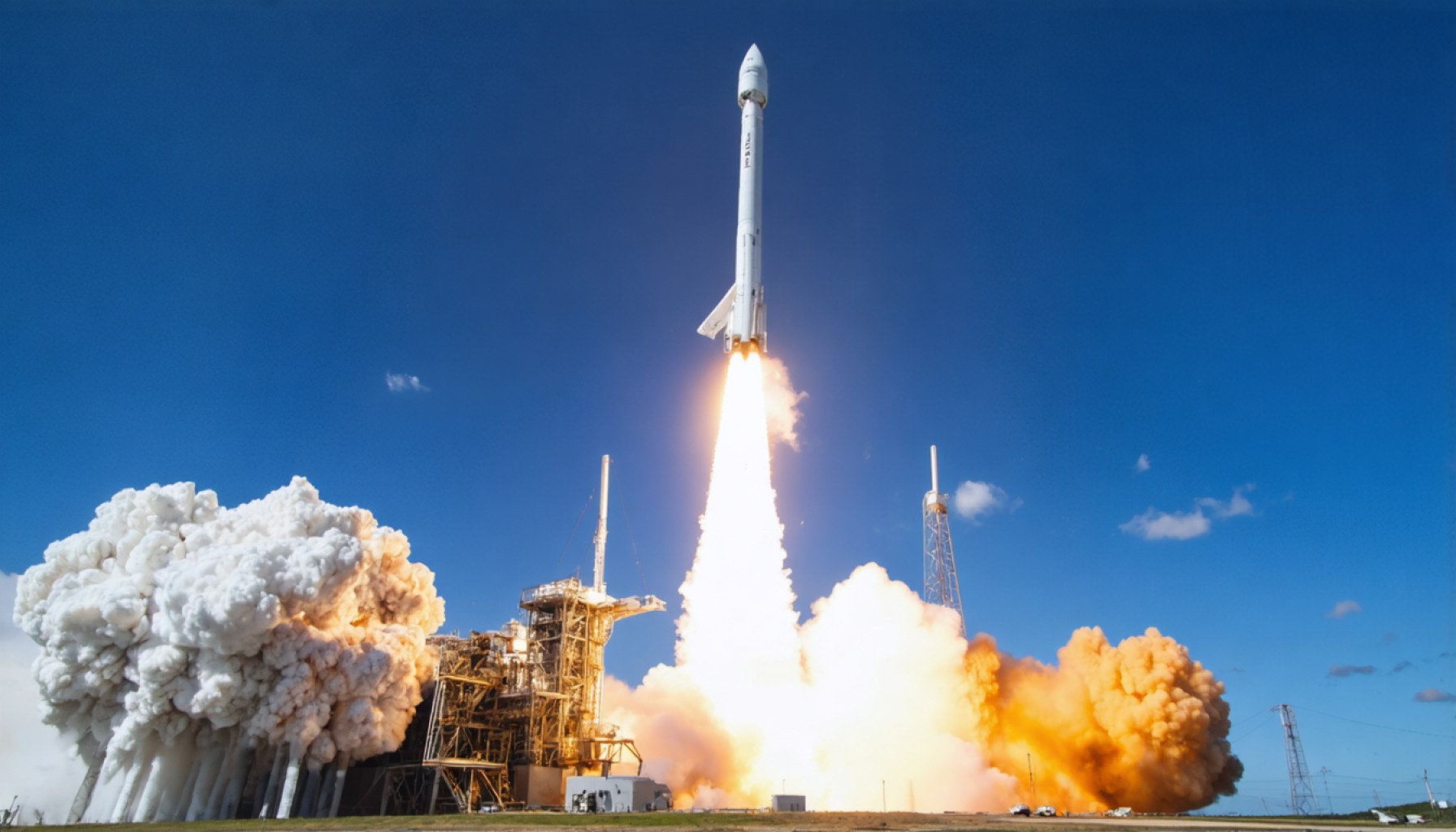- SpaceX’s Falcon 9 launched from California’s Vandenberg Space Force Base, expanding the Starlink satellite constellation aimed at enhancing global internet coverage.
- The rocket, on its fifth flight, has previously participated in missions like NROL-126 and Transporter-12, showcasing its engineering resilience.
- The first stage of Falcon 9 was successfully recovered on the droneship “Of Course I Still Love You,” demonstrating precise technological execution.
- Starlink aims to provide high-speed internet to the world’s most remote areas, part of SpaceX’s mission to bridge digital divides under Elon Musk’s leadership.
- This mission embodies SpaceX’s broader vision of breaking barriers in communication and connectivity, offering limitless possibilities for the future.
A narrow window opened over California’s Vandenberg Space Force Base as the clock edged past 9:00 p.m.—the perfect stage for SpaceX’s Falcon 9 to soar into the dusky sky. The scene was nothing short of cinematic: a brilliant blaze of rocket engines piercing the cool night air, carving a path to the stars. Yet this spectacle held more than visual allure; it carried the invisible promise of connectivity, one that reaches out across continents and oceans.
This particular Falcon 9 had weathered the cosmos on four previous flights, its robust frame a testament to the resilience of modern engineering. Each mission—NROL-126, Transporter-12, SPHEREx, and NROL-57—had etched stories into its metal skin, stories of exploration and of expanding the boundaries of human endeavor. Now, its mission was to deliver Starlink satellites into low-Earth orbit, a critical step in advancing global internet coverage.
As the rocket ascended, shedding its stages, the drama of the moment climaxed with the first stage’s descent. Gracefully and precisely, it maneuvered its return, following a flawless arc toward its oceanic runway. The droneship, aptly named “Of Course I Still Love You”, lay waiting in the Pacific’s gentle embrace. This automated sea-float, a marvel in its own right, marked the intersection of human aspiration and technological triumph.
What does this mean in the broader picture? Starlink’s constellation grows ever larger, stitching a web around our globe with the intention to bring high-speed internet to even the most remote corners. Imagine a world where every whisper of wind in a secluded village or every distant wave crest carries a signal of connection and opportunity. That vision is slowly materializing with each successful mission.
SpaceX, under the visionary leadership of Elon Musk, continues to redefine the space frontier. The Falcon 9 launches are not merely technical achievements but symbolize a broader human pursuit. The relentless drive to innovate, to use technology as a bridge across divides, shines brightly amidst the quiet starscape, promising a future where no one remains in communicative darkness.
As Falcon 9’s latest journey reminds us, the sky is not the limit—it is merely the beginning. With each orbiting satellite, SpaceX brings us a step closer to a world united by seamless connectivity. And in that connected world, the possibilities are as infinite as the universe itself.
How SpaceX and Starlink Are Shaping the Future of Global Connectivity
The Promise of Starlink
SpaceX’s ambitious Starlink project aims to create a vast network of low-Earth orbit satellites to provide high-speed internet access across the globe. The recent Falcon 9 launch from Vandenberg Space Force Base marks another successful mission, expanding Starlink’s growing constellation. This network is pivotal in delivering reliable internet services to underserved and remote regions, bridging the digital divide.
Real-World Use Cases
1. Remote Education: In regions with limited internet access, Starlink’s service can enable remote learning, opening educational opportunities to students in rural and isolated areas.
2. Disaster Zone Communication: In areas struck by natural disasters, traditional communication infrastructure is often damaged. Starlink can provide crucial internet connectivity where it’s needed most urgently.
3. Maritime Internet: Ships and yachts traversing oceans can benefit from Starlink’s coverage, ensuring continuous high-speed internet even when far from land.
Technical Specifications and Pricing
Starlink’s setup includes a phased-array antenna and satellite dish known for its easy installation. The service operates on a subscription basis—current pricing is competitive but varies based on region and logistical factors. Customers typically need to purchase the hardware kit.
Security and Sustainability Considerations
While Starlink offers significant benefits, there are security concerns related to potential vulnerabilities in satellite internet systems. Additionally, sustainability in terms of orbital space debris is a challenge that SpaceX addresses by planning the deorbit of defunct satellites to minimize long-term accumulation.
Market Forecasts and Industry Trends
The satellite internet market is poised for rapid expansion. Analysts predict significant growth, driven by the demand for high-speed internet in underserved areas, increasing reliance on cloud services, and the Internet of Things (IoT). As competitors like Amazon’s Project Kuiper enter the market, competition is likely to spur further advancements in technology and accessibility.
Pros and Cons Overview
Pros:
– Wide coverage, especially beneficial for remote areas.
– High-speed and low-latency internet service.
– Flexibility and quick deployment compared to ground-based infrastructure.
Cons:
– Initial setup costs may be high for some users.
– Service quality can be affected by satellite density in specific regions.
– Concerns over light pollution affecting astronomical observations.
Actionable Tips
1. Stay Updated: Follow SpaceX’s official channels for the latest news on Starlink’s expansions and service availability in your area.
2. Evaluate Alternatives: Compare Starlink with local internet providers to determine the best option for your needs.
3. Be Sustainable: If you’re considering Starlink, stay informed about its environmental impact and choose responsibly.
Related Links
For more information about SpaceX and their advancements, visit SpaceX.
In conclusion, SpaceX’s Starlink project holds the potential to revolutionize global communications by providing high-speed internet access to all corners of the Earth. As the network expands, it promises to unlock new opportunities for education, economic development, and connectivity, narrowing the digital divide and fostering a more interconnected world.
